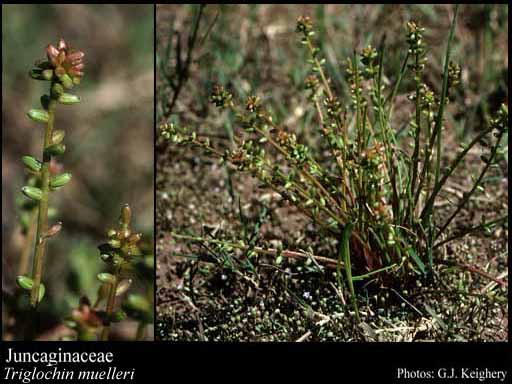- Reference
- Demonstr.Pl. 9 (1808)
- Name Status
- Current







Scientific Description
Common name. Arrow-grass Family.
Habit and leaf form. Herbs; laticiferous (rarely — Lilaea), or non-laticiferous and without coloured juice. Perennial (usually), or annual; plants with a basal concentration of leaves; rhizomatous, or tuberous, or bulbaceous (very rarely). Hydrophytic, or helophytic (sometimes halophytic); when hydrophytic, rooted. Leaves small, or medium-sized; alternate; spiral, or spiral to distichous (‘spirodistichous’); sessile; sheathing. Leaf sheaths with free margins. Leaves edgewise to the stem, or with ‘normal’ orientation; simple; epulvinate. Leaf blades entire; flat; linear (occasionally reduced to the sheath); parallel-veined. Leaves ligulate; with stipules, or without stipules. Axillary scales present. Leaves with a persistent basal meristem, and basipetal development. Stem anatomy. Secondary thickening absent.
Reproductive type, pollination. Fertile flowers functionally male, or functionally female, or hermaphrodite, functionally male, and functionally female. Unisexual flowers present. Plants dioecious, or polygamomonoecious. Anemophilous.
Inflorescence and flower features. Flowers aggregated in ‘inflorescences’; in racemes and in spikes. The terminal inflorescence unit racemose. Inflorescences scapiflorous; terminal; dense or sparse spikes and racemes. Flowers ebracteate; small; regular; 1 merous (Lilaea), or 2 merous, or 3 merous; cyclic. Perigone tube absent. Perianth of ‘tepals’ (there being one member outside each stamen or staminode), or absent (if the ‘tepals’ are interpreted as staminal appendages — cf. Potamogetonaceae); 6 (usually), or 3, or 4, or 1; 2 -whorled (usually), or 1 -whorled; isomerous; free; sepaloid; without spots, or spotted (Tetroncium); similar in the two whorls. Fertile stamens present, or absent (female flowers). Androecium 6 (usually), or 3 (when the inner whorl missing), or 8 (rarely), or 1 (rarely). Androecial members adnate (if the flower is interpreted as having a perianth); free of one another; 1 -whorled, or 2 -whorled ((4+4) 3+3 or 2+2, rarely only three or one). Androecium exclusively of fertile stamens, or including staminodes (alternate members sometimes sterile). Staminodes when present, 3, or 4. Stamens 3, or 6, or 8 (rarely); isomerous with the perianth, or diplostemonous; filantherous to with sessile anthers. Anthers dehiscing via longitudinal slits; extrorse; tetrasporangiate. Fertile gynoecium present, or absent (male flowers). Gynoecium 6 carpelled, or 4 carpelled, or 1 carpelled. Carpels isomerous with the perianth. Gynoecium apocarpous, or syncarpous, or monomerous; eu-apocarpous to semicarpous, or synovarious (usually in two trimerous or dimerous whorls, the carpels usually adnate to the central axis but separating at maturity); superior. Carpel non-stylate, or stylate; apically stigmatic; 1 ovuled. Placentation basal (usually), or apical (Maundia). Ovary plurilocular. Gynoecium non-stylate, or stylate. Stigmas dry type; papillate; Group II type. Placentation basal to axile (usually), or apical (Maundia). Ovules 1 per locule; ascending (usually), or pendulous (Maundia); non-arillate; anatropous (usually), or orthotropous (Maundia).
Fruit and seed features. Fruit non-fleshy; an aggregate, or not an aggregate. The fruiting carpels (if apocarpous, or considered so) coalescing into a secondary syncarp to not coalescing. The fruiting carpel dehiscent, or indehiscent; a follicle, or an achene. Fruit (if syncarpous) a schizocarp. Mericarps comprising achenes, or comprising follicles. Seeds non-endospermic; with starch. Cotyledons 1. Embryo straight. Seedling. Hypocotyl internode absent. Mesocotyl absent. Seedling collar not conspicuous. Cotyledon hyperphyll elongated; assimilatory; more or less circular in t.s. Coleoptile absent. Seedling non-macropodous. Seedling cataphylls absent. First leaf centric. Primary root ephemeral.
Geography, cytology, number of species. World distribution: widespread North and South temperate and frigid. X = 6, 8, 9. 25 species.